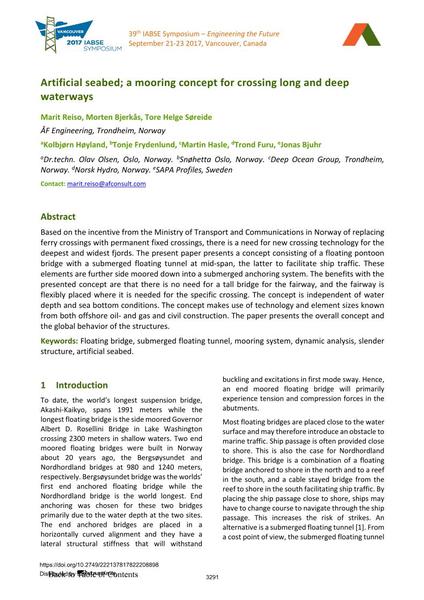Artificial seabed; a mooring concept for crossing long and deep waterways

|
|
|||||||||||
Bibliografische Angaben
| Autor(en): |
Marit Reiso
(ÅF Engineering, Trondheim, Norway)
Morten Bjerkås (ÅF Engineering, Trondheim, Norway) Tore Helge Søreide (ÅF Engineering, Trondheim, Norway) Kolbjørn Høyland (aDr.techn. Olav Olsen, Oslo, Norway. bSnøhetta Oslo, Norway. cDeep Ocean Group, Trondheim, Norway. dNorsk Hydro, Norway. eSAPA Profiles, Sweden) Tonje Frydenlund (aDr.techn. Olav Olsen, Oslo, Norway. bSnøhetta Oslo, Norway. cDeep Ocean Group, Trondheim, Norway. dNorsk Hydro, Norway. eSAPA Profiles, Sweden) Martin Hasle (aDr.techn. Olav Olsen, Oslo, Norway. bSnøhetta Oslo, Norway. cDeep Ocean Group, Trondheim, Norway. dNorsk Hydro, Norway. eSAPA Profiles, Sweden) Trond Furu (aDr.techn. Olav Olsen, Oslo, Norway. bSnøhetta Oslo, Norway. cDeep Ocean Group, Trondheim, Norway. dNorsk Hydro, Norway. eSAPA Profiles, Sweden) Jonas Bjuhr (aDr.techn. Olav Olsen, Oslo, Norway. bSnøhetta Oslo, Norway. cDeep Ocean Group, Trondheim, Norway. dNorsk Hydro, Norway. eSAPA Profiles, Sweden) |
||||
|---|---|---|---|---|---|
| Medium: | Tagungsbeitrag | ||||
| Sprache(n): | Englisch | ||||
| Tagung: | IABSE Symposium: Engineering the Future, Vancouver, Canada, 21-23 September 2017 | ||||
| Veröffentlicht in: | IABSE Symposium Vancouver 2017 | ||||
|
|||||
| Seite(n): | 3291-3298 | ||||
| Anzahl der Seiten (im PDF): | 8 | ||||
| Jahr: | 2017 | ||||
| DOI: | 10.2749/222137817822208898 | ||||
| Abstrakt: |
Based on the incentive from the Ministry of Transport and Communications in Norway of replacing ferry crossings with permanent fixed crossings, there is a need for new crossing technology for the deepest and widest fjords. The present paper presents a concept consisting of a floating pontoon bridge with a submerged floating tunnel at mid-span, the latter to facilitate ship traffic. These elements are further side moored down into a submerged anchoring system. The benefits with the presented concept are that there is no need for a tall bridge for the fairway, and the fairway is flexibly placed where it is needed for the specific crossing. The concept is independent of water depth and sea bottom conditions. The concept makes use of technology and element sizes known from both offshore oil- and gas and civil construction. The paper presents the overall concept and the global behavior of the structures. |
||||
| Stichwörter: |
dynamische Berechnung
|
||||
